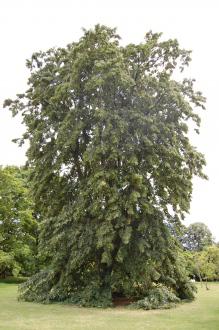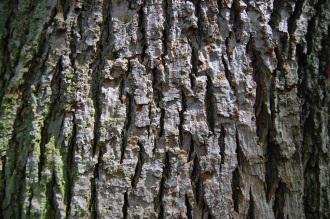
Tilia tomentosa ‘Petiolaris’ Flower (28/07/2012, Kew Gardens, London)
Position: Full sun to partial shade
Soil: Moist, well drained
Flowering period: Summer
Eventual Height: 30m
Eventual Spread: 15m
Hardiness: USDA Zone 4b-10a
Family: Malvaceae
Tilia tomentosa ‘Petiolaris’ is a fast growing deciduous tree with a broadly columnar, weeping habit. Its mid to dark green leaves are cordate with serrate margins, occasionally lobed, densely white-hairy underneath, are up to 10cm long and 8cm broad. Its branches droop, producing the pendulous effect. Its green/ yellow fragrant flowers are borne in cymes of up to ten. Its fruit are drupes which are up to 1cm long.

Tilia tomentosa ‘Petiolaris’ (28/07/2012, Kew Gardens, London)
Tilia tomentosa ‘Petiolaris’, commonly known as the Weeping Silver Lime or Silver Pendant Lime. The species Tilia tomentosa is native to southwestern Asia. Tilia tomentosa ‘Petiolaris’ is synonymous with Tilia ‘Petiolaris’.
The etymological root of the binomial name Tilia is the ancient Latin name for the Lime Tree. Tomentosa is derived from Latin tomentum meaning ‘the hairy stuffing of a pillow’, in reference to the hairy undersides of the leaves. Petiolaris refers to the distinct petioles of this tree.
The landscape architect may find Tilia tomentosa ‘Petiolaris’ useful as an urban park specimen tree. It is also suitable for use as a hedging species. Once established this tree is drought tolerant. It is tolerant of pollution and soil compaction.

Tilia tomentosa ‘Petiolaris’ Bark (28/07/2012, Kew Gardens, London)
Ecologically, Tilia tomentosa ‘Petiolaris’ is pollinated by honeybees, however it is toxic to other bees that cannot digest its nectar, shown by large numbers of comatose bees below the tree while it is in inflorescence.
The Royal Horticultural Society has given Tilia tomentosa ’Brabant’ their prestigious Award of Garden Merit in 1993. T. ‘Brabant’ has a symmetrical conical crown.

Tilia tomentosa ‘Petiolaris’ Leaf (28/07/2012, Kew Gardens, London)
Tilia tomentosa ‘Petiolaris’ prefers moist, well-drained soils. It tolerates most pH of soil, although it prefers an alkaline pH.
Tilia tomentosa ‘Petiolaris’ requires little maintenance. Hedge pruning or the removal of dead or damaged material should be carried out from mid-summer to mid-winter to minimise wound bleed. This plant can also withstand a very hard pruning.

